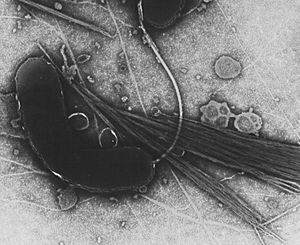Gammaproteobacteria facts for kids
Quick facts for kids Gammaproteobacteria |
|
|---|---|
 |
|
| Vibrio cholerae | |
| Scientific classification | |
| Domain: | |
| Phylum: | |
| Class: |
Gammaproteobacteria
|
| Orders | |
|
|
Gammaproteobacteria are a very large and important group of bacteria. They are a class of bacteria, which means they are a major division within the larger group called Proteobacteria. These tiny living things are found almost everywhere on Earth!
Many well-known bacteria belong to this group. Some of them can cause illnesses in people, like Vibrio cholerae which causes cholera. Others, like Pseudomonas aeruginosa, can cause infections, especially in hospitals. But not all Gammaproteobacteria are harmful; many are very helpful and play important roles in nature.
All Gammaproteobacteria are gram-negative bacteria. This is a way scientists classify bacteria based on their cell wall structure. It affects how they react to certain stains in a lab test.
Contents
What are Gammaproteobacteria?
Gammaproteobacteria are single-celled organisms, too small to see without a microscope. They are part of the domain Bacteria, which is one of the main groups of all living things. They are incredibly diverse, meaning they come in many shapes and sizes and live in many different places.
Where do they live?
You can find Gammaproteobacteria in all sorts of environments. They live in:
- Soil
- Water (freshwater, saltwater, and even hot springs)
- Plants
- Animals (including humans!)
- Even extreme places like deep-sea vents
Their ability to adapt to so many different conditions makes them very successful.
Important Gammaproteobacteria
This group includes some of the most studied and well-known bacteria. Let's look at a few examples:
Enterobacteriales
This group includes many bacteria that live in the guts of animals and humans. Some are harmless, but others can cause problems.
- Escherichia coli (often called E. coli): Most types of E. coli are harmless and live in our intestines, helping us digest food. However, some types can cause food poisoning.
- Salmonella: These bacteria are known for causing foodborne illnesses, often from contaminated food like raw chicken or eggs.
- Klebsiella: These are common in the environment and can sometimes cause infections in people, especially in hospitals.
Vibrionales
Bacteria in this group often live in water environments.
- Vibrio cholerae: This bacterium is famous for causing the disease cholera, which leads to severe dehydration. It's usually spread through contaminated water.
Pseudomonadales
These bacteria are very common in soil and water.
- Pseudomonas aeruginosa: This bacterium is found almost everywhere. It can cause infections in people, especially those with weakened immune systems or cystic fibrosis. It's also known for being resistant to some medicines.
Other Interesting Types
- Legionellales: This group includes Legionella pneumophila, which can cause a serious lung infection called Legionnaires' disease. It often spreads through contaminated water systems, like air conditioning units.
- Chromatiales: These are often called "purple sulfur bacteria." They are unique because they can make their own food using sunlight, similar to plants, but they use sulfur compounds instead of water. You can find them in places like hot springs and stagnant water.
Roles in Nature and Health
Gammaproteobacteria play many different roles in the world.
Environmental Roles
- Nutrient Cycling: Many Gammaproteobacteria are involved in important cycles that keep our planet healthy. For example, some help break down dead plants and animals, returning nutrients to the soil. Others help with the nitrogen cycle, changing nitrogen into forms that plants can use.
- Bioremediation: Some types can help clean up pollution! They can break down harmful chemicals in the environment, like oil spills or industrial waste. This process is called bioremediation.
Health Roles
- Human Microbiome: Many Gammaproteobacteria live harmlessly in our bodies, especially in our gut. They are part of our microbiome, the community of microbes that help us stay healthy, digest food, and even train our immune system.
- Pathogens: As mentioned, some Gammaproteobacteria can cause diseases in humans, animals, and plants. Understanding how they cause illness helps scientists develop ways to treat and prevent infections.
Studying Gammaproteobacteria
Scientists study Gammaproteobacteria for many reasons:
- To understand how they cause diseases and find new medicines.
- To learn how they help the environment and use them for cleaning up pollution.
- To discover new types of bacteria and understand the diversity of life on Earth.
Because they are so common and diverse, Gammaproteobacteria are a fascinating group for scientists to research.
See also

- In Spanish: Proteobacterias gamma para niños

